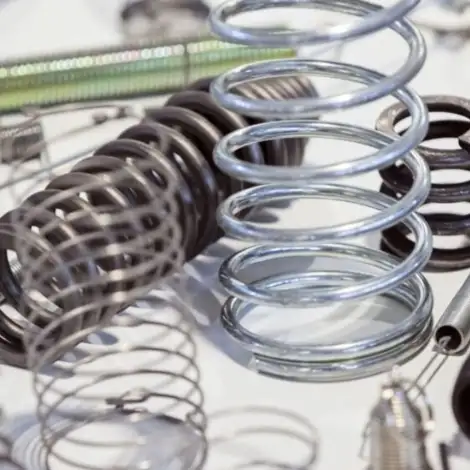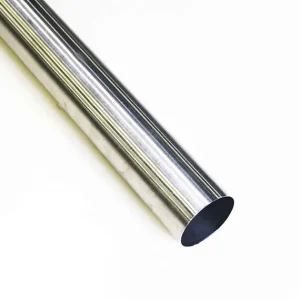Incoloy A-286 spring wire is a precipitation-hardening, iron-nickel-chromium alloy chosen when springs must combine very high tensile strength, good notch-rupture resistance and oxidation/corrosion resistance up to roughly 700°C (≈1300°F). For spring work it is supplied as wire or strip and is normally cold-worked then aged to reach spring temper — typical spring tensile strength after aging is ~1100–1300 MPa (160–190 ksi) depending on wire finish and heat treatment. For demanding aerospace, oil & gas and turbocharger applications, A-286 offers an excellent balance of mechanical performance and fabricability compared with alternative high-temperature alloys.
What is Incoloy A-286 alloy spring material?
Alloy A-286 is an iron-based, austenitic, precipitation-hardening superalloy with significant nickel and chromium and deliberate additions of titanium, molybdenum and small vanadium/boron levels. It was developed for high-temperature fasteners and springs where strength and oxidation resistance are required up to about 700°C (≈1300°F). In spring form it is used where space is tight, loads are cyclic, and elevated-temperature strength or superior notch performance are critical — e.g., aerospace actuator springs, turbocharger return springs, downhole tool components and high-temperature valves.
Typical spring use cases
-
High-temperature coil and compression springs in engine/turbomachinery.
-
Conical and wave springs for exhaust and turbo systems.
-
Corrosion-exposed springs in oil & gas (when teamed with appropriate coatings or in compatible environments).
-
Precision spring elements in aerospace actuators and control assemblies.
-
Fastener springs and critical small-part wireforms where weight, fatigue life and creep resistance matter.
Chemical composition
The composition below is the commonly specified nominal range used for A-286 (UNS S66286 / W. Nr. 1.4980 / EN X6NiCrTiMoVB25-15-2). Manufacture specifications and acceptance limits depend on the AMS/ASTM/EN standard used by buyer/seller.
| Element | Typical range (wt.%) |
|---|---|
| Nickel (Ni) | 24.0 – 27.0 |
| Chromium (Cr) | 13.5 – 16.0 |
| Iron (Fe) | Balance |
| Titanium (Ti) | 1.9 – 2.35 |
| Molybdenum (Mo) | 1.0 – 1.5 |
| Vanadium (V) | 0.10 – 0.50 |
| Carbon (C) | ≤ 0.08 (typical) |
| Silicon (Si) | ≤ 1.0 |
| Manganese (Mn) | ≤ 1.0 |
| Phosphorus (P) & Sulfur (S) | Trace / typical low ppm levels |
(These ranges are compiled from major datasheets and wire suppliers; purchaser technical specifications may narrow some limits.)
Material / mechanical properties
A-286 is normally supplied in solution-annealed and/or cold-worked form and then precipitation-aged for final strength. The table below lists typical values used by spring designers — final results vary with cold work, wire diameter and aging schedule.
| Condition | Typical tensile strength | Typical yield (0.2% offset) | Suggested operating temp range |
|---|---|---|---|
| Annealed (soft) | ~550–760 MPa (80–110 ksi) | ~300–500 MPa | -200°C to +400°C |
| Cold-worked + aged (spring temper) | ~1100–1300 MPa (160–190 ksi) | ~900–1150 MPa | -200°C to +400°C (short exposures to ~700°C depending on load) |
| Creep/rupture capability | Retains significant strength to ≈700°C (1300°F) | — | Service limit often given as ≈700°C for strength/oxidation behavior |
Designers commonly specify final aged tensile and stress-relaxation limits rather than relying on annealed values alone; fatigue life benefits from appropriate aging after forming to lock in precipitation structure.
Manufacturing notes — wire, coiling, and heat treatment for springs
Practical tips from springmakers and wire vendors:
-
Raw wire: A-286 is offered in round wire, flat wire and strand/rope forms. For springmaking, cold-drawn round wire is most common.
-
Solution anneal: Typical solution anneal around 980–1050°C (1800–1920°F) to dissolve prior precipitates. Wire is then furnace cooled or quenched per spec.
-
Cold forming: Springs should be formed in the annealed or partially cold-worked condition using standard spring coiling equipment, avoiding excessive local heating.
-
Aging (precipitation hardening): A standard aging cycle for spring temper is ≈704–760°C (1300–1400°F) for ~16 hours (exact schedule depends on part mass) followed by slow furnace cooling or controlled air cooling to develop the Ni-Ti/Mo precipitates giving the high tensile strengths used for springs. When springs are coiled in annealed condition, aging after coiling produces optimum strength and fatigue performance.
-
Surface finish: For fatigue-critical springs a smooth bright finish and shot peening are recommended; wire drawing lubricants and surface defects should be tightly controlled.
-
Stress-relief and temper sequence: Avoid multiple high-temperature cycles after final aging — each reheating can change the precipitation state and relaxation behavior.
These practices are widely accepted among aerospace and industrial spring manufacturers and reflected in wire datasheets.
Corrosion behaviour and temperature limits
-
General corrosion: A-286 has corrosion resistance comparable to some austenitic stainless steels in neutral and mildly oxidizing environments; it is not as resistant as super-austenitic or nickel-moly grades in severe chloride or reducing acid environments. Use caution in seawater or sour (H₂S) conditions — specify NACE/ISO compatibility where required.
-
High-temperature oxidation: It performs well in oxidizing atmospheres up to ~700°C; carburizing or sulfidizing atmospheres reduce life and require special consideration.
-
Fatigue at temperature: Elevated-temperature fatigue and stress-relaxation behavior must be checked; A-286 holds static strength to ~700°C but cyclic life and relaxation depend heavily on stress level, temperature and surface finish.
If the service involves hydrogen sulfide, sour gas or highly acidic media, consult NACE MR0175 / ISO 15156 and supplier guidance before selecting A-286.
Specifications and standards
Common standards and specifications under which A-286 products appear:
-
UNS S66286 and W. Nr. 1.4980 (EN) designations.
-
AMS: AMS 5731 / AMS 5732 / AMS 5737 / AMS 5525 (wire, bar and fasteners) — widely used in aerospace procurement.
-
ASTM/ASME: ASTM A453 / ASTM A638 often reference Grade 660 (A-286 family) forms.
-
NACE MR0175 / ISO 15156-3: relevant for oil & gas service where sulfide stress cracking compatibility is required (supplier confirmation required).
When purchasing, always specify the AMS/ASTM/EN standard you require plus heat-treatment condition (solution treated, aged, cold-worked + aged) and request material certificates (MTC) certifying UNS and test results.
Common equivalents and cross references
A-286 is commonly listed with these cross-references and trade names:
-
UNS S66286 (most common).
-
W. Nr. 1.4980 / EN X6NiCrTiMoVB25-15-2.
-
AISI/SAE 660 (often used interchangeably in some supply chains).
-
Trade names: Incoloy A-286, Pyromet A-286, Cronifer 1525 Ti and others used by mill brands.
Note: “Equivalent” in chemistry and mechanical behavior can vary by spec — always check the exact AMS/ASTM/EN spec, tensile/yield targets, heat treatment and acceptance criteria before substituting alloys.
Buying checklist for A-286 spring wire
When requesting quotes or ordering, include:
-
UNS / EN / AMS numbers and required condition (e.g., UNS S66286, solution annealed, cold drawn, aged).
-
Wire diameter/size, tolerance and finish (bright vs pickled).
-
Required tensile/yield/elongation acceptance values at final condition.
-
Required certificates: EN 10204 3.1/3.2 or equivalent MTC.
-
NDT or lab tests (chemical analysis, hardness, tensile, microstructure) and inspection hold points.
-
Fatigue or stress-relaxation tests if the spring is life-critical.
-
Traceability: mill heat number and batch records.
-
Packaging and shipping (coiled spools vs straight lengths) and lead time.
2025 global price guide for Incoloy A-286 (spring wire / bar)
Important: Nickel-alloy prices fluctuate with metal surcharges, alloy premiums, order quantity, form (wire vs bar), specs (AMS vs commodity), and mill availability. The ranges below are indicative 2025 retail/distributor ranges compiled from market listings and supplier quotes — treat them as procurement starting points, not fixed quotes.
| Region | Typical 2025 distributor range (USD/kg) | Notes / drivers |
|---|---|---|
| China (mill & trading portals) | USD $10 – $40 / kg | Many small lots on portals show $25–35/kg for bars; bright wire and AMS spec increase price. |
| India (stockists, fabricators) | USD $20 – $65 / kg | Smaller domestic stock, import costs and certification increase price. |
| Europe (distributors, certified AMS/EN material) | USD $30 – $90 / kg | AMS/EN certified bar/wire with inspection documents commands higher premiums. |
| USA (specialty distributors, certified aerospace stock) | USD $35 – $120 / kg | Aerospace AMS/heat-treated product and short lead times are pricier. |
| Middle East / MENA | USD $25 – $80 / kg | Sourced via traders; price sensitive to shipping and customs. |
Notes on price drivers
-
Alloy surcharges and nickel market swings alter base metal costs; mills also add processing and certification premiums. Special Metals publishes periodic surcharges that influence final quotes.
-
Small MOQ (under 50–100 kg), unusual diameters, or AMS certification add significant per-kg costs.
-
For spring wire, further drawing, bright finish, spooling and QC add cost versus raw bar.
FAQs
1. What sizes/textures does A-286 spring wire come in?
Round wire from small diameters (fractions of mm up to several mm) in bright or pickled finish; also flat wire and strand are available. Suppliers specify tolerances.
2. Can A-286 be used continuously at 700°C?
A-286 retains strength up to ≈700°C for many static applications but long-term creep and cyclic fatigue at that temperature require engineering review. For continuous creep service above ~600–650°C, select specialized high-temperature alloys.
3. Is A-286 magnetic?
In solution-treated condition it is essentially austenitic and non-magnetic; after heavy cold work some magnetic response may appear but for most designs it is considered non-magnetic.
4. What heat treatment should I use after coiling springs?
Typical aging: 1300–1400°F (704–760°C) for ~16 hours after coiling (exact schedule depends on mass). Always follow wire vendor recommendations and validate with sample testing.
5. How does A-286 compare with Inconel 718 for springs?
A-286 is iron-based with Ni ~25%; Inconel 718 is nickel-based with different precipitation hardening (Nb, Al, Ti). For many high-temp spring uses A-286 gives good strength and cost balance; 718 may be chosen where higher corrosion resistance or different temperature/fatigue behavior is required. Material selection must be application specific.
6. Is A-286 suitable for sour service (H₂S)?
Not by default. For oil & gas sour environments, compliance with NACE MR0175 / ISO 15156 must be demonstrated; often a different alloy or special qualification is chosen.
7. What documentation should accompany deliveries?
Minimum: mill heat number traceability and a 3.1/3.2 MTC (chemical and mechanical test results). For aerospace, AMS certifications and additional testing are standard.
8. Can A-286 be welded on springs?
Welding changes the local heat treatment and precipitation state; welding is possible but requires post-weld heat treatment and qualified procedures — not typically done on finished springs.
9. What is a reasonable lead time for factory-direct orders from China?
For stocked sizes, 1–2 weeks; for custom diameters, AMS specs or large AMS-certified lots, 3–8 weeks depending on mill/backlog. (Estimate only — request current lead times from supplier.)
10. How to maximize fatigue life of A-286 springs?
Control surface finish (bright wire), eliminate machining marks, use shot peening, design with sufficient mean stress margin, and apply post-form aging to set precipitates and reduce stress relaxation.





